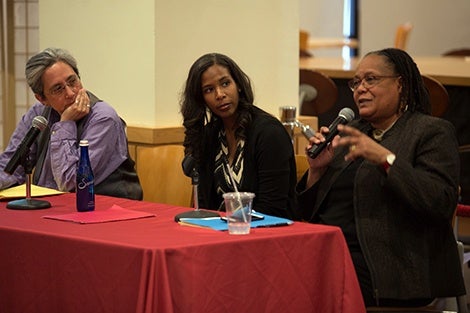May 8, 2017—In the 18th through early 20th centuries, white physicians studied black slaves and their descendants in an attempt to identify characteristics that were distinctive of their race. They believed that all questions about health could be answered in the body; therefore, if blacks had poorer health outcomes than whites, the differences must be due to inherent racial weaknesses, not disparities in economic circumstance. This research played a significant role in constructing a narrative of race in the United States, the repercussions of which are still being felt in the lives and health of African Americans today.
The legacy of slavery was the focus at the Slavery & Public Health: Past, Present, and Future symposium, held May 5, 2017 at Harvard T.H. Chan School of Public Health. The event grew out of efforts by Harvard University to uncover its links to slavery, highlighted at a conference in March. For the Harvard Chan School symposium, faculty, students, and staff came together in Kresge Cafeteria for panel discussions, followed by a reception marking the installation of the Ghost Portraits exhibition in Rosenau Atrium. These black and white images portray significant African Americans and Native Americans in public health history.

Opening the event, Betty Johnson, assistant dean for faculty and staff diversity, said that for the School to become an inclusive environment, the community must reflect on its history. She said, “The past never dies or disappears, and we can’t erase it.”
During the first panel, Rana Hogarth, assistant professor of history at the University of Illinois, described several historical instances of white physicians’ use of race as a medically significant marker of difference. For example, in the 1700s, when yellow fever rates in the U.S. were higher among whites than blacks, physicians assumed that racial differences in immunity were the cause. In fact, those blacks who were immune had most likely contracted the disease as children in the countries from which they were enslaved. When a yellow fever epidemic broke out in Philadelphia in 1793, blacks were expected to stay to tend to the white population. Too late, it was discovered that blacks were not inherently immune, and many became sick and died.
Evelynn Hammonds, Barbara Gutmann Rosenkrantz Professor of History of Science and professor of African and African American Studies at Harvard University, noted that free blacks after the Civil War were the first advocates for federal health care. They argued that the right to health care should be among the benefits of being a citizen of the United States.
The discriminatory Jim Crow laws enacted in southern and some western states following the Civil War also took a toll on the health of African Americans. Nancy Krieger, professor of social epidemiology shared research findings documenting higher black infant mortality rates in Jim Crow states prior to the passage of the 1964 Civil Rights Act, which abolished the laws. She has also done research showing heightened risk of estrogen-receptor-negative breast cancer (which tends to have worse survival rates than ER-postive breast cancer) among African American women raised in Jim Crow states.
Other Harvard Chan School community members participating in the event included Reginald Tucker-Seeley, assistant professor of social and behavioral sciences; Rhea Boyd, MPH ’17; Elizabeth Solomon, assistant director for academic affairs and fellowship programs; Meredith Rosenthal, senior associate dean for academic affairs and professor of health economics and policy; and Ra’Shaun Nalls, associate director of community engagement.
Photos: Noah Leavitt
